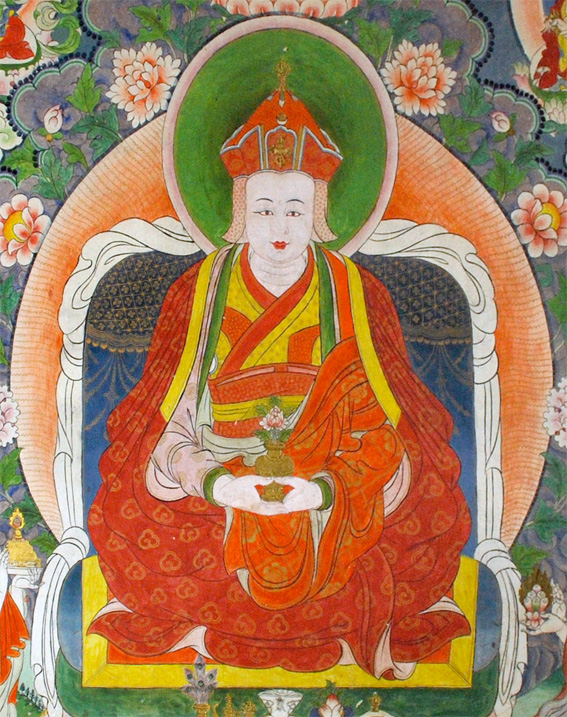Biography and autobiography in Tibet are important sources for both education and inspiration. Tibetans have kept such meticulous records of their teachers that thousands of names are known and discussed in a wide range of biographical material. All these names, all these lives—it can be a little overwhelming. The authors involved in the Treasury of Lives are currently mining the primary sources to provide English-language biographies of every known religious teacher from Tibet and the Himalaya, all of which are organized for easy searching and browsing. Every Tuesday on the Tricycle blog, we will highlight and reflect on important, interesting, eccentric, surprising and beautiful stories found within this rich literary tradition. This week’s post summarizes the biography of Pema Lingpa by Ariana Maki on the Treasury of Lives.
Pema Lingpa

Pema Lingpa (1450–1521) is one of the most beloved figures of Bhutanese history and one of the most important treasure revealers of the Nyingma tradition of Tibetan Buddhism, in which he is the fourth of the five “kingly treasure revealers.” The activity of treasure revelation is not without controversy: accused during his life of being a fraud, Pema Lingpa’s career remains one of the best examples of bold and resourceful revelation.
Born in the Bumtang region of Bhutan, Pema Lingpa trained as a blacksmith with his maternal grandfather, who brought him to be blessed by the son of the great treasure revealer Dorje Lingpa (1346–1405). It was from him that he received the name Orgyen Pema Lingpa.
Pema Lingpa developed considerable skill working with iron—so much so that later in life he would be accused of forging with his own hands the iron caskets he would extract from cliff faces—but religious life beckoned. At the age of 25 he began to experience prophetic dreams. Two years later he envisioned a shabbily dressed monk who gave him a scroll on which it was commanded that he and five friends go to Naring Drak to reveal treasure. His father dismissed the prophecy, but his, or possibly an aunt, encouraged him to follow the instructions.
What followed is one of the most famous treasure revelation events in Nyingma history. On the appointed night, in the presence of five friends, Pema Lingpa went to Naring Drak. Without warning and without uttering a word, Pema Lingpa stripped naked and dove into the small lake below the cliff. It is said that he found a large underwater cave, and upon entering, saw a throne and a stack of texts. The guardian of the cave took one of the texts, pushed it toward him, and told him to run. Pema Lingpa came to his senses at the surface of the water and felt himself propelled up to the cliff as if swept by a wind.
He returned home to share the text with his parents and two masters of the nearby Tarpeling Monastery. After consulting the key that had been given to him by the shabby-looking monk, he was able to decipher the text, Crystallization of the Tantra of Luminous Space, considered the first of his 32 revelations. He soon began giving initiations and teachings, and it is said that during the night dakini would visit him in dreams to teach him the steps of different sacred dances and give him further instructions.
Many additional revelations followed, and Pema Lingpa quickly became famous. With fame came detractors. Nyingma literature is full of defenses against accusations of inauthenticity, and one method of defense is to admit that there have indeed been fraudulent treasure revealers—men and women who have exploited credulous townsfolk with claims that their own creations were the word of the Buddha. But the tradition insists that the authentic can easily be differentiated from the fake. Pema Lingpa developed his own method for proving his legitimacy, making him perhaps the first treasure revealer to engage in the practice of “public revelation,” as exemplified by his very first treasure extraction in the presence of five companions. Treasures said to be extracted in private were dubious, but it was harder to dispute a revelation attended by multiple witnesses.
One later revelation was expressly in response to allegations by a local ruler that Pema Lingpa was a fake. Before the ruler and a large crowd back at Naring Drak, Pema Lingpa took a burning butter lamp and proclaimed, “If I am genuine, let me bring back the treasure with this lamp still burning. If I am a fraud, let me die in the waters below.” He dove in and resurfaced some time later holding a small box crafted from joined skulls, a small sculpture, and the butter lamp still alight. According to tradition, this miraculous occurrence inspired all those present to become followers and patrons of Pema Lingpa, and also gave the small lake its present name, Mebartso, or “Burning Lake.”
Pema Lingpa’s lineage continues through three lines of incarnations: the Peling Sungtrul, the Peling Tukse, and the Peling Gyelse, also known as the Gangteng Tulku.